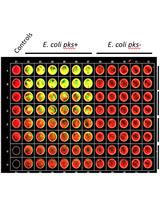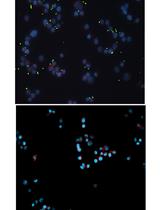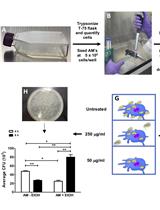- Submit a Protocol
- Receive Our Alerts
- Log in
- /
- Sign up
- My Bio Page
- Edit My Profile
- Change Password
- Log Out
- EN
- EN - English
- CN - 中文
- Protocols
- Articles and Issues
- For Authors
- About
- Become a Reviewer
- EN - English
- CN - 中文
- Home
- Protocols
- Articles and Issues
- For Authors
- About
- Become a Reviewer
Adhesion of Moraxella catarrhalis to Respiratory Tract Epithelial Cells
Published: Vol 3, Iss 21, Nov 5, 2013 DOI: 10.21769/BioProtoc.956 Views: 9790
Reviewed by: Fanglian He

Protocol Collections
Comprehensive collections of detailed, peer-reviewed protocols focusing on specific topics
Related protocols

Quantification of Colibactin-associated Genotoxicity in HeLa Cells by In Cell Western (ICW) Using γ-H2AX as a Marker
Sophie Tronnet and Eric Oswald
Mar 20, 2018 8030 Views

Adhesion of Enteroaggregative E. coli Strains to HEK293 Cells
Jorge Luis Ayala-Lujan and Fernando Ruiz-Perez
Apr 20, 2018 6830 Views

Intracellular Invasion and Killing Assay to Investigate the Effects of Binge Alcohol Toxicity in Murine Alveolar Macrophages
Victor Jimenez Jr and Fernando P Monroy
Jan 20, 2019 6695 Views
Abstract
Moraxella catarrhalis is a human-restricted pathogen that is responsible for respiratory tract infections such as childhood otitis media (OM) and exacerbation of chronic obstructive pulmonary disease (COPD) in adults. Successful colonization and infection by M. catarrhalis depends on its ability to attach to the respiratory tract mucosal epithelium. This protocol describes a method to measure adherence of M. catarrhalis to epithelial cell lines in vitro.
Keywords: Moraxella catarrhalisMaterials and Reagents
- Human pharyngeal epithelial cell line Detroit 562 (ATCC, catalog number: CCL-138 )
- Type II alveolar epithelial cell line A549 (ATCC, catalog number: CCL-185 )
- DMEM + GlutaMAXTM-I (Life Technologies, Invitrogen™, catalog number: 31966-047 )
- Fetal calf serum (FCS) (Greiner Bio-One GmbH, catalog number: 758093S5403 )
- Trypsin-EDTA (0.25%-1 mM) (Life Technologies, catalog number: 25300-054 )
- Brain heart infusion (BHI) (Becton Dickinson and Company, catalog number: 237500 ) broth and BHI agar plates
- Antibiotics: spectinomycin or kanamycin (Merck KgaA, Calbiochem, catalog numbers: 567570-10 and 420311-5 )
- Bovine skin gelatin (Sigma-Aldrich, catalog number: G9382-100G )
- Glycerol (Merck KgaA, catalog number: 1.04092.1000)
- PBS without Ca2+ and Mg2+ (Westburg BV, catalog number: BE17-516F/12 )
- Saponin (Sigma-Aldrich, catalog number: 47036-50G-F )
Equipment
- 24-well tissue culture plate (Falcon®, catalog number: 353407 )
- 75 cm2 culture flask
- Centrifuge
- CO2 incubator
- Benchtop Incubator Shaker
Procedure
- The human pharyngeal epithelial cell line Detroit 562 and the type II alveolar epithelial cell line A549 were routinely grown in DMEM with GlutaMAXTM-I and 10% FCS at 37 °C and 5% CO2.
- For passage or seeding purposes epithelial cells were washed once in 10 ml PBS and detached using trypsin-EDTA as follows: add 3 ml Trypsin-EDTA per 75 cm2 culture flask, incubate 5 min at 37 °C and 5% CO2 until cells have detached from the bottom, collect cells with 7 ml culture medium, count cells, spin required amount for 5 min at 400 x g, resuspend pellet in required volume of culture medium.
- Two days prior to the adherence assay, 2 x 105 Detroit 562 cells per well were seeded into a 24-well tissue culture plate, and after one day, the growth medium was refreshed.
- A549 cells were seeded into 24-well tissue culture plates one day prior to the assay at 4 x 105 cells.
- For both cell lines, monolayers of approximately 1 x 106 cells per well were used for adherence assays.
- M. catarrhalis strains were inoculated on brain heart infusion (BHI) plates (supplemented with antibiotics when required) and grown overnight at 37 °C in an atmosphere containing 5% CO2.
- Bacteria were harvested from plate and resuspended in PBS supplemented with 0.15% gelatin (PBS-G).
- This suspension was used to inoculate BHI broth to an OD620 nm of ~ 0.05 and grown at 37 °C at 200-250 rpm until OD620 nm of 1.0 to 1.2. Subsequently, glycerol was added to a final concentration of 20%, and 1-ml aliquots were stored at -80 °C.
- Before each assay, bacteria were thawed on ice, washed once in 1 ml DMEM with GlutaMAXTM-I and 1% FCS (infection medium) and resuspended in the infection medium to 1 x 107 CFU ml-1.
- Epithelial cells were washed twice with 1 ml PBS, infected with 1 ml of the M. catarrhalis suspension (multiplicity of infection, 10 bacteria per cell), centrifuged for 5 minutes at 200 x g to facilitate contact between bacteria and cells, and incubated 1 h at 37 °C in a 5% CO2 environment.
- Non-adherent bacteria were removed by 3 washes with 1-ml PBS (PBS was added and subsequently carefully aspirated, no agitation). Detroit 562 or A549 cells were detached and lysed by addition of 1 ml 1% saponin in PBS-G followed by incubation at 37 °C and 5% CO2 for 10 min.
- CFUs were enumerated by plating 10-fold serial dilutions on BHI plates supplemented with the appropriate antibiotics. The percentage adherence of the mutants was calculated as the fraction of the inoculum that bound to the Detroit 562 cells.
Acknowledgments
This protocol was published in: de Vries et al. (2013). This study was financially supported by Vienna Spot of Excellence (VSOE) grant (ID337956).
References
- de Vries, S. P., Burghout, P., Langereis, J. D., Zomer, A., Hermans, P. W. and Bootsma, H. J. (2013). Genetic requirements for Moraxella catarrhalis growth under iron-limiting conditions. Mol Microbiol 87(1): 14-29.
Article Information
Copyright
© 2013 The Authors; exclusive licensee Bio-protocol LLC.
How to cite
Vries, S. P. D. and Bootsma, H. J. (2013). Adhesion of Moraxella catarrhalis to Respiratory Tract Epithelial Cells. Bio-protocol 3(21): e956. DOI: 10.21769/BioProtoc.956.
Category
Microbiology > Microbe-host interactions > In vitro model > Cell line
Cell Biology > Cell structure > Cell adhesion
Do you have any questions about this protocol?
Post your question to gather feedback from the community. We will also invite the authors of this article to respond.
Share
Bluesky
X
Copy link











